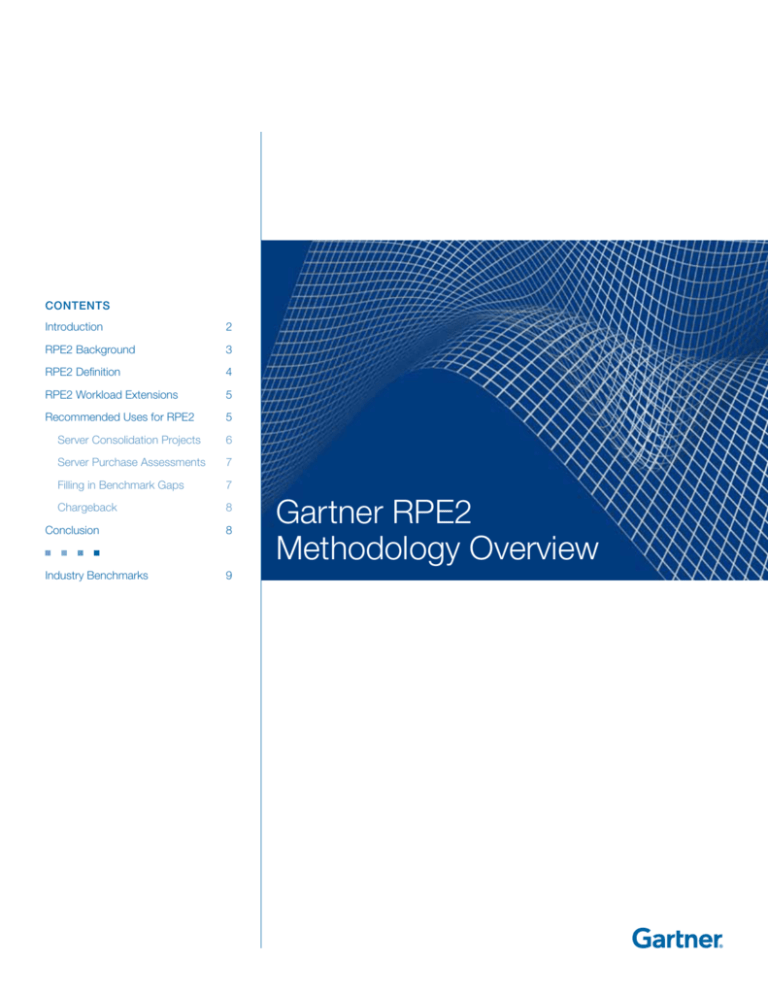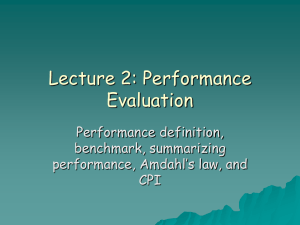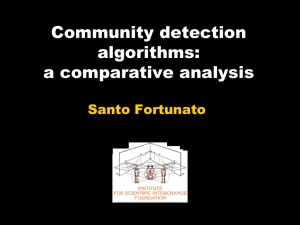
CONTENTS
Introduction2
RPE2 Background3
RPE2 Definition4
RPE2 Workload Extensions 5
Recommended Uses for RPE2
5
Server Consolidation Projects 6
Server Purchase Assessments
7
Filling in Benchmark Gaps 7
Chargeback
8
Conclusion8
Industry Benchmarks
9
Gartner RPE2
Methodology Overview
Gartner RPE2
Methodology Overview
Among the Gartner research and advisory products are tools to help clients
understand and compare various characteristics of server systems, including
pricing, features and performance. Our server performance estimates are
powered by a methodology called Relative Performance Estimate 2 (RPE2).
RPE2 provides rapid approximate assessments of relative server performance.
These performance estimates aid in comparing servers, making server
recommendations or purchase decisions, analyzing server consolidation
and technology refresh scenarios, capacity planning, and defining
chargeback valuations.
This overview serves as an important reference for users of RPE2. It explains how
the performance estimates are derived and how they can be utilized.
Introduction
Comparing the performance of computer systems can be a difficult task.
Unlike most other high-technology and mass consumer products, servers
have little objective information available to help users quantify performance
capabilities in absolute or relative terms. Server manufacturers are not obligated
to provide standardized performance data on products, as they are with power
characteristics.
In the absence of mandatory standards for specifying server performance, the
IT industry has evolved a number of performance benchmarks. Some of these
benchmarks are regulated by industry consortiums, others are created by
individual hardware or software vendors, and still others are created by third-party
companies or individuals. Benchmarks vary in terms of the workloads simulated,
the runtime complexity involved, the system characteristics measured and the
rules applied for testing and reporting results.
Users who require performance estimates often find available benchmark results
inadequate. Common reasons for this inadequacy include:
• Data is not available for the specific product(s) users wish to evaluate.
• Data that is available focuses on only a subset of system performance or does
Ideas International was acquired in 2012
by Gartner, Inc. The acquisition includes
proprietary methodologies such as RPE2.
2
not reflect the workload(s) users intend to run.
• Data is only available from a source with a possible conflict of interest, such as a
seller promoting the purchase of a specific product.
Gartner RPE2
Methodology Overview
The chances that relevant benchmark data will not be found are greater when
users are trying to compare servers from different manufacturers, different
architectures or different generations.
In the absence of comprehensive, relevant and comparable data from
manufacturers, we created a theoretical performance estimate called RPE2.
The objective of RPE2 is to provide users with comparable performance
information for server products. RPE2 accomplishes this by incorporating
the following:
• A composite workload profile
• Coverage of all x86, IA-64 and RISC server variants from the leading
global manufacturers
• Coverage of current and obsolete server models
RPE2 is a theoretical performance estimate and not an actual observed
measurement of server performance. It is largely based on published benchmark
results and relative performance ratings from server manufacturers.
Like any single metric, RPE2 can provide useful information, but it can also be
misapplied. Later in this document we will be discussing recommended ways of
using the relative performance data as support for server selection or for various
aspects of operational planning.
RPE2 Background
The original performance ranking data for enabling architecture-independent
server comparisons was introduced in the late 1990s. This ranking series, known
as RPE, was based purely on a single lightweight online transaction processing
(OLTP) workload.
The focus on a single benchmark workload presented a number of limitations and
risks. So in order to better represent and expand the wide breadth of workloads
and software stacks being deployed on servers and to increase the pool of
reference benchmark data points, a composite benchmark methodology was
initiated. In 2005, the new enhanced ranking methodology, RPE2, was introduced
as the replacement performance ranking series for server comparisons and
consolidation tools.
3
Gartner RPE2
Methodology Overview
RPE2 Definition
RPE2 is a composite benchmark, meaning that server performance characteristics
are captured and calibrated against multiple workload profiles represented by
a mix of industry benchmarks that have the widest technology coverage. The
published or estimated performance points for each server processor option are
aggregated by calculating a geometric mean value. In the standard RPE2, all
components are weighted equally to prevent RPE2 from skewing toward a single
benchmark or workload type. Other weighting options are described below.
A composite mix benchmark offers the following advantages:
• The multiple components represent a broader range of workloads and server
architecture characteristics.
• Multiple components enable the impact of benchmark life cycles to be
managed in a less disruptive manner; benchmark substitution can be handled
within the existing framework, and the overall spectrum of results can be kept
broadly consistent.
• Multiple components increase the likelihood that more absolute performance
values contribute directly to the composite.
• Multiple components enable the incorporation of additional components and
mitigate the enforced loss of a single component.
The initial RPE2 benchmark set was selected from all available industry and
ISV benchmarks based on how complete their coverage was for the major
manufacturers and server architectures, and the extent of their published
results. The current RPE2 set includes the following six benchmark inputs in
its calculation: SAP SD Two-Tier, TPC-C, TPC-H, SPECjbb2005, and two
SPEC CPU2006 components.
As additional performance points for missing technologies appear in other existing
benchmarks, or if new industry benchmarks are developed that potentially satisfy
our selection criteria, they will also be considered for inclusion within the RPE2
composite.
The primary objective for RPE2 is to reflect benchmarked server family
relationships and vendor ranking data on a benchmark component-by-component
basis. The RPE2 calculation process extrapolates and interpolates the best-case
performance data from multiple benchmark sources, including relative performance
data provided by server manufacturers. By representing a broader spectrum of
measured outcomes, the RPE2 values are more representative of overall server
capability and the range of applications now being consolidated on virtualized
server environments.
4
Gartner RPE2
Methodology Overview
The RPE2 performance rankings are designed to provide users with the most
accurate and comprehensive coverage of available server performance. RPE2
data covers all processor configuration options for x86, IA-64 and RISC servers
for major vendors from 1997 onward — over 24,000 configurations in all.
RPE2 also has several other virtues not found in any other performance-ranking data:
• Independence. RPE2 was developed and is maintained by an independent
analyst company.
• Transparency. RPE2 is the only composite benchmark mix that is
fully documented.
• Comprehensiveness. RPE2 is the only composite ranking that incorporates
multiple workload types and covers all major technologies and architectures.
• Durability. RPE2 is designed to adapt to the availability and life cycle of the
individual benchmark components; RPE2 continues even when constituent
benchmarks change, become obsolete or are replaced.
RPE2 Workload Extensions
In 2010, RPE2 was expanded to include Workload Extensions. Workload
Extensions use different weightings of the constituent benchmark components
of RPE2 in order to highlight performance within specific workload profiles.
The following RPE2 Workload Extensions were created:
• RPE2-ERP, highlighting the SAP SD Two-Tier component
• RPE2-Java, highlighting the SPECjbb2005 component
• RPE2-OLTP, highlighting the TPC-C component
• RPE2-Compute-Intensive, highlighting the SPEC CPU2006 components
Recommended Uses For RPE2
Users can leverage RPE2 performance data in the following situations:
• When the performance data they want is not published or is too difficult to obtain
• When they want a quick performance assessment to get them into the right
range or to narrow a list of servers for deeper evaluation
• When they want an independent comparison to verify the reasonableness of data
provided by a third party (for example, a nonpublic performance comparison
provided by a manufacturer)
• When they need a relative performance ratio in order to estimate or extrapolate
some other benchmark or metric
• When they need an index to compare dissimilar systems for a business purpose,
such as a rating to use in a chargeback system
5
Gartner RPE2
Methodology Overview
While RPE2 provides a readily accessible, inclusive and convenient measure of
server performance, quantitative benchmarking of specific workloads on target
servers will likely provide higher accuracy than RPE2 in terms of predicting
performance. We recommend that, when they exist, users should utilize workloador application-specific performance benchmarks over RPE2 to estimate the
performance of those workloads on specific servers.
Before reviewing RPE2 usage in more detail, RPE2 should be placed into the
context of its primary sources. Because RPE2 values are mainly derived from
benchmarks and other information provided by manufacturers, the caveats that
the manufacturers apply to their own performance data must also apply to RPE2.
Therefore, the following cautionary statements apply to RPE2:
• The source data may include manufacturer performance rankings, which are
largely based on estimates rather than actual performance measurements.
• RPE2 and RPE2 Workload Extensions are based on benchmarks that include
a mix of workloads with different characteristics, and these may not be
representative of a user’s intended workload.
• The published benchmark results used in the calculation of RPE2 are generally
tuned by manufacturers for maximum possible performance, and, therefore, they
may be dependent on specific hardware configurations, software packages and/
or kernel, middleware and database settings in the software stack.
The following sections review each of the RPE2 usage scenarios in more detail.
Note that Gartner also provides tools to undertake many of these specific tasks
Server Consolidation Projects
Typically there are four major practical problems with server consolidation projects:
1. The number of servers needing to be analyzed and/or replaced is
overwhelmingly large — perhaps many hundreds or thousands.
2. The environment is likely to consist of a wide mix of products with different
architectures from various manufacturers, making objective, relative
comparisons difficult.
3. Many installed servers are likely to be older or obsolete models for which
manufacturer product lists or server management databases have
no information.
4. Consolidation projects must be financially justified up front; quick rough
estimates of scope and cost are needed before the time or money is available
to perform in-depth analysis and consolidation planning.
6
Gartner RPE2
Methodology Overview
In light of these challenges, how do you estimate how many servers can be
consolidated on a given platform, and/or which servers are appropriate targets
for consolidating a specific inventory?
We offer a solution that addresses these questions: ServerCAR (Server
Consolidation Analysis Resource). The Server Consolidation online tool covers
a very comprehensive list of servers (over 24,000 entries), along with their
associated RPE2 values and environmental profiles, dating from 1997 onward.
Server Consolidation enables users to calculate the aggregate performance,
memory and environmental details (such as power, heat output and rack space)
of installed servers and then determine replacement options irrespective of the
server technologies involved.
Server Purchase Assessments
RPE2 data is utilized by the Gartner Technology Planner for Technical Professionals
and the IDEAS Competitive Profiles information services. These services offer
comprehensive coverage of the comparative features, pricing and performance
characteristics of a wide range of enterprise servers sold across major global
markets. They use RPE2 data to identify which servers are likely to compete with
each other based on their performance profile. This capability can be useful as a
quick server shortlisting function.
Filling in Benchmark Gaps
Probably the most effective use of RPE2 data is for filling in gaps in benchmark
coverage. A user will often know which benchmark is a good surrogate for his or
her workload. However, the result pool for that benchmark may not include data
on the specific server model the user intends to buy (or has already purchased).
In this instance, adjusting the benchmark result of a tested model by the RPE2
ratio of the target to the tested model will give a good estimate of the target
absolute benchmark value. This process assumes that the two models (tested and
target) are from the same server family and are reasonably close in age and chip
or core count. The further apart the models are within the range ranking table, the
less reliable the estimated outcome will be.
Extrapolations of this nature can best be used as part of purchase assessments,
as described previously, or for making capacity planning estimates in the absence
of application-specific sizing tools.
7
Gartner RPE2
Methodology Overview
Chargeback
RPE2 data can be used as an independent contributor to the establishment
of chargeback rates. In such instances, this data can serve as a useful way of
converting metered computing resources on various platforms into a harmonized
charge-out algorithm.
Conclusion
While many server performance benchmarks exist, they frequently offer
insufficient or inappropriate data for making sound assessments of relative
server performance. RPE2 provides an accurate, independent and quick
source of performance estimates to address this issue. RPE2 was developed
to fill the extensive vacuum of missing performance information left by the
server manufacturers. When used in conjunction with other Gartner services,
RPE2 data effectively supplements industry benchmark information and
serves as a productivity aid for making rapid approximate assessments.
To learn how to access RPE2 or to discuss any questions you might have,
please contact your Gartner account executive.
8
Industry Benchmarks
The following provides some background on the industry-standard benchmarks
referenced in this overview.
Transaction Processing Performance Council (TPC)
The TPC is a nonprofit organization that develops transaction-processing and
database benchmarks. Generally, TPC benchmark results must be audited before
they become official, and TPC benchmarks are among the few that require full
disclosure of system price along with performance. Gartner is an associate
member of the TPC. For more information, consult the TPC website at
http://www.tpc.org.
TPC-C. First released in 1992, this OLTP benchmark has been run on servers
of many different architectures. The TPC-C test suite simulates an online orderprocessing system, executing transactions such as storing orders into a database
and checking the status of existing orders. This benchmark tests not only the
compute capabilities of the processor, but also the performance and capacity
of memory and I/O. The longevity of TPC-C makes it useful for comparing the
performance of older servers against the performance of current systems.
TPC-E. In 2007, the TPC introduced a transaction-oriented benchmark that was
intended to supplant TPC-C. As of April 2012, published results have been limited
to a subset of architectures and technologies. Until TPC-E results are published on
a broader set of products, the benchmark has limited usefulness for a composite
benchmark like RPE2 that covers a wide variety of server architectures.
TPC-H. TPC-H is an ad hoc decision support benchmark that simulates complex
search queries presented to a large database. To account for performance
variances associated with the data-set size, TPC-H can be run across six different
scales (database sizes) that range from 100 GB to 30 TB. Both the hardware
configured and the database software deployed are significant contributors to
TPC-H performance.
9
Industry Benchmarks
Standard Performance Evaluation Corporation (SPEC)
The nonprofit SPEC develops a number of benchmark suites that test specific
subsystems of server hardware and software. Gartner is a member of the Open
Systems Group (OSG) of SPEC. For more information, consult the SPEC website
at http://www.spec.org.
SPEC CPU2006. SPEC CPU2006 runs compute-intensive workloads and
consists of two benchmark suites: “INT” for measuring compute-intensive
integer performance, and “FP” for measuring compute-intensive floating-point
performance. The data used by the floating-point tests generally does not
completely fit within internal processor caches; thus, these tests also stress the
processor’s cache/memory hierarchy. The SPEC CPU2006 suite replaced an
earlier CPU2000 suite, which itself was the successor of an earlier SPEC
CPU benchmark.
SPECjbb2005. SPECjbb benchmarks evaluate the performance of servers running
typical Java business applications, as well as aspects of the Java virtual machine
(JVM). They simulate a three-tier client/server system and report results in bops
(business operations per second). In addition to testing the processor and memory,
these benchmarks also stress the operating system and JVM components.
SAP Standard Application Benchmarks
Unlike the benchmarks from SPEC and the TPC, the SAP benchmarks are
controlled by a single company (SAP) and its partners, rather than an industry
consortium. These benchmarks are designed to test the hardware and database
performance of SAP applications and components. For more information, consult
the SAP benchmarks website at http://www.sap.com/solutions/benchmark/index.epx.
SAP Sales and Distribution (SD) Two-Tier. This benchmark quantifies the
performance of the SAP SD application, one of the many SAP application
solutions. It measures a system with a database, server(s) and some form of
SAP’s enterprise resource planning (ERP) software.
10
GARTNER HEADQUARTERS
Corporate Headquarters
56 Top Gallant Road
Stamford, CT 06902-7700
U.S.A.
+1 203 964 0096
Europe Headquarters
Tamesis
The Glanty
Egham
Surrey, TW20 9AW
UNITED KINGDOM
+44 1784 431611
Asia/Pacific Headquarters
Gartner Australasia Pty. Ltd.
Level 9, 141 Walker Street
North Sydney
New South Wales 2060
AUSTRALIA
+61 2 9459 4600
Japan Headquarters
Gartner Japan, Ltd.
Atago Green Hills MORI Tower 5F
2-5-1 Atago, Minato-ku
Tokyo 105-6205
+81 3 6430 1800 JAPAN
+81 3 3481 3670
Latin America Headquarters
Gartner do Brasil S/C Ltda
Av. Das Nações Unidas 12551, 25
Unit 2501 A
São Paulo 04578-903
BRAZIL
+55 11 3043 7544
ABOUT GARTNER
Gartner, Inc. (NYSE: IT) is the world’s leading information technology research and advisory
company. We deliver the technology-related insight necessary for our clients to make the
right decisions, every day. From CIOs and senior IT leaders in corporations and government
agencies, to business leaders in high-tech and telecom enterprises and professional services
firms, to technology investors, we are the valuable partner to clients in 12,000 distinct
organizations. Through the resources of Gartner Research, Gartner Executive Programs,
Gartner Consulting and Gartner Events, we work with every client to research, analyze and
interpret the business of IT within the context of their individual role. Founded in 1979, Gartner
is headquartered in Stamford, Connecticut, U.S.A., and has 5,200 associates, including 1,280
research analysts and consultants, and clients in 85 countries.
© 2012 Gartner, Inc. and/or its affiliates. All rights reserved. Gartner is a registered trademark of Gartner, Inc. or its affiliates.
For more information, email info@gartner.com or visit gartner.com. Produced by Gartner Marketing Communications HTGRPE2OVRBROC080112









